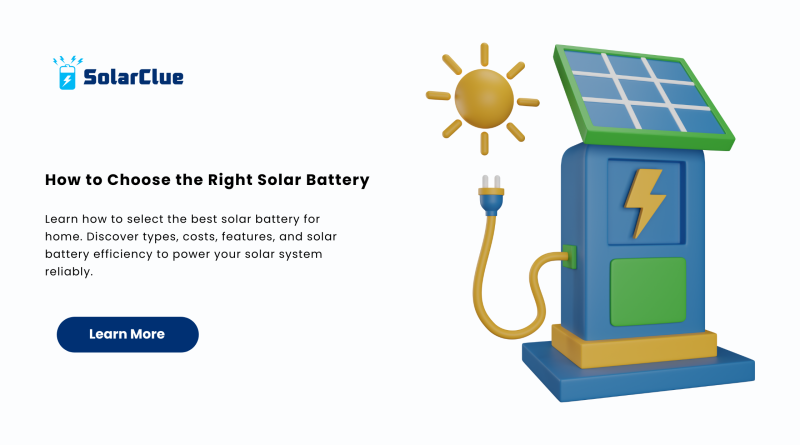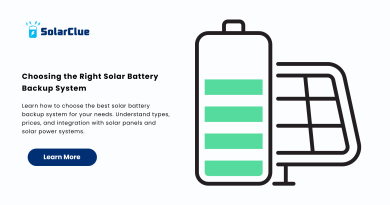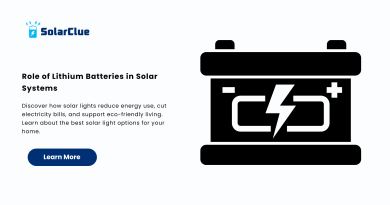How to Choose the Right Solar Battery
If you’ve installed a solar system or plan to do so, choosing the best solar battery for home is essential. Solar batteries ensure uninterrupted power, especially during outages or nighttime when the sun isn’t shining. But with so many types and technical terms in the market, it’s easy to feel overwhelmed. This guide breaks down everything you need to know about selecting the right solar battery, including performance, pricing, and solar battery efficiency.
Table of Contents
- 1 Why a Solar Battery is Important
- 2 Types of Solar Batteries
- 3 Key Features to Evaluate
- 4 Best Solar Battery Brands in India (2025)
- 5 How Much Does a Solar Battery Cost?
- 6 Ideal Battery Sizing for Homes
- 7 Integration with Solar Power System
- 8 Maintenance Tips
- 9 Real-Life Scenario
- 10 Government Subsidies and Support
- 11 Myths About Solar Batteries
- 12 FAQs
Why a Solar Battery is Important
A solar battery stores the electricity generated by your solar panels, allowing you to use the power whenever you need it. Whether it’s during nighttime or when there’s a blackout, the stored energy keeps your home running. With electricity bills rising and grid reliability varying across India, having a reliable solar battery for home is no longer optional—it’s a smart investment.
Types of Solar Batteries
Before choosing the best solar battery, it’s important to understand the common types available:
1. Lead-Acid Batteries
These are the most widely used in India. They come in tubular and flat plate varieties and are generally affordable.
- Pros: Cost-effective, easily available, proven technology
- Cons: Bulky, needs maintenance, shorter lifespan
2. Lithium-Ion Batteries
Gaining popularity in 2025 due to high solar battery efficiency, these batteries are compact and maintenance-free.
- Pros: Lightweight, longer lifespan, higher efficiency
- Cons: Higher upfront cost
3. Gel Batteries
These are maintenance-free and safer than traditional lead-acid.
- Pros: Low self-discharge, minimal maintenance
- Cons: Lower energy density compared to lithium-ion
Key Features to Evaluate

When selecting the best solar battery for home, you must consider these essential criteria:
1. Battery Capacity
Measured in Ah (ampere-hours), capacity indicates how much energy the solar battery can store. For example, a 150Ah battery will power more devices or last longer than a 100Ah one.
2. Depth of Discharge (DoD)
This refers to how much energy you can use from the battery without damaging it. A battery with 80–90% DoD is ideal.
3. Round-Trip Efficiency
Higher solar battery efficiency means more usable energy. Lithium-ion batteries typically offer over 90% efficiency.
4. Battery Life and Warranty
Look for batteries with a lifespan of at least 5–10 years. Brands offering warranties of 5 years or more are preferable.
5. Maintenance Requirements
Go for maintenance-free options like lithium-ion or gel if you want hassle-free performance.
Best Solar Battery Brands in India (2025)
Here are some trusted names for the best solar battery in India:
Luminous Solar Battery
- Known for its high capacity tubular batteries
- Affordable and widely used in residential systems
Exide Solar Tubular Battery
- Long-lasting performance
- Available in multiple capacity options
Amaron Solar Battery
- High-temperature tolerance
- Efficient charge and discharge cycles
Loom Solar Battery
- Compact lithium batteries for modern homes
- Ideal for smart solar kits and tight spaces
How Much Does a Solar Battery Cost?
The price depends on battery type and capacity:
| Type | Capacity | Price Range (INR) |
|---|---|---|
| Lead-Acid | 100–200Ah | ₹8,000–₹18,000 |
| Gel Battery | 100–150Ah | ₹10,000–₹22,000 |
| Lithium-Ion | 1–3kWh | ₹20,000–₹60,000 |
Remember, cheaper batteries may cost more in the long run due to replacement and maintenance.
Ideal Battery Sizing for Homes
- 1kW solar system: 100Ah battery minimum
- 3kW solar system: 200–300Ah
- 5kW solar system: 400Ah or lithium-ion pack
Your energy needs, backup duration, and peak usage hours will determine the optimal size.
Integration with Solar Power System
Ensure your inverter supports the type of solar battery you plan to install. Some hybrid inverters work best with lithium-ion batteries, while older ones may support only lead-acid.
Also, ensure proper battery cabinet, cooling, and ventilation—especially for lead-acid batteries.
Maintenance Tips
- Keep terminals clean and rust-free
- For lead-acid, check electrolyte levels monthly
- Monitor DoD and recharge before it hits zero
- Use monitoring apps for lithium-ion models
Real-Life Scenario
Mr. Arora from Jaipur chose a 3kW system with a Luminous 200Ah tubular battery. With frequent outages and high evening usage, his solar battery for home now supports fans, lights, and even his refrigerator for 6 hours daily. “It changed how we use energy,” he says, “I feel independent and secure.”
Government Subsidies and Support
Though solar batteries aren’t directly subsidized under most schemes, their cost may be bundled in complete solar kits eligible for MNRE support. Always confirm with your installer.
Myths About Solar Batteries
Myth 1: Batteries are not needed in cities.
Truth: With rising outages, every urban home benefits from battery backup.
Myth 2: Lithium batteries are too expensive.
Truth: They offer more savings in the long run.
Myth 3: Maintenance is a hassle.
Truth: Gel and lithium-ion options require near-zero maintenance.
FAQs
1. What’s the best solar battery for Indian homes?
Luminous and Exide tubular batteries are most popular, while Loom Solar lithium batteries are rising in demand.
2. How do I calculate battery size?
Total your daily energy consumption and divide by system voltage.
3. How long do solar batteries last?
Lead-acid: 5–7 years; Lithium-ion: 10–12 years.
4. Are solar batteries safe indoors?
Yes, especially gel and lithium-ion types.
5. Can I upgrade later?
Yes, modular systems allow battery expansion.
Choosing the right solar battery isn’t just about storage—it’s about control, reliability, and peace of mind. Take charge of your power needs with the best solar battery for home. Explore top-rated batteries at solarclue.com and discover in-depth tips and reviews at blog.solarclue.com—because your energy choices today shape your tomorrow.




